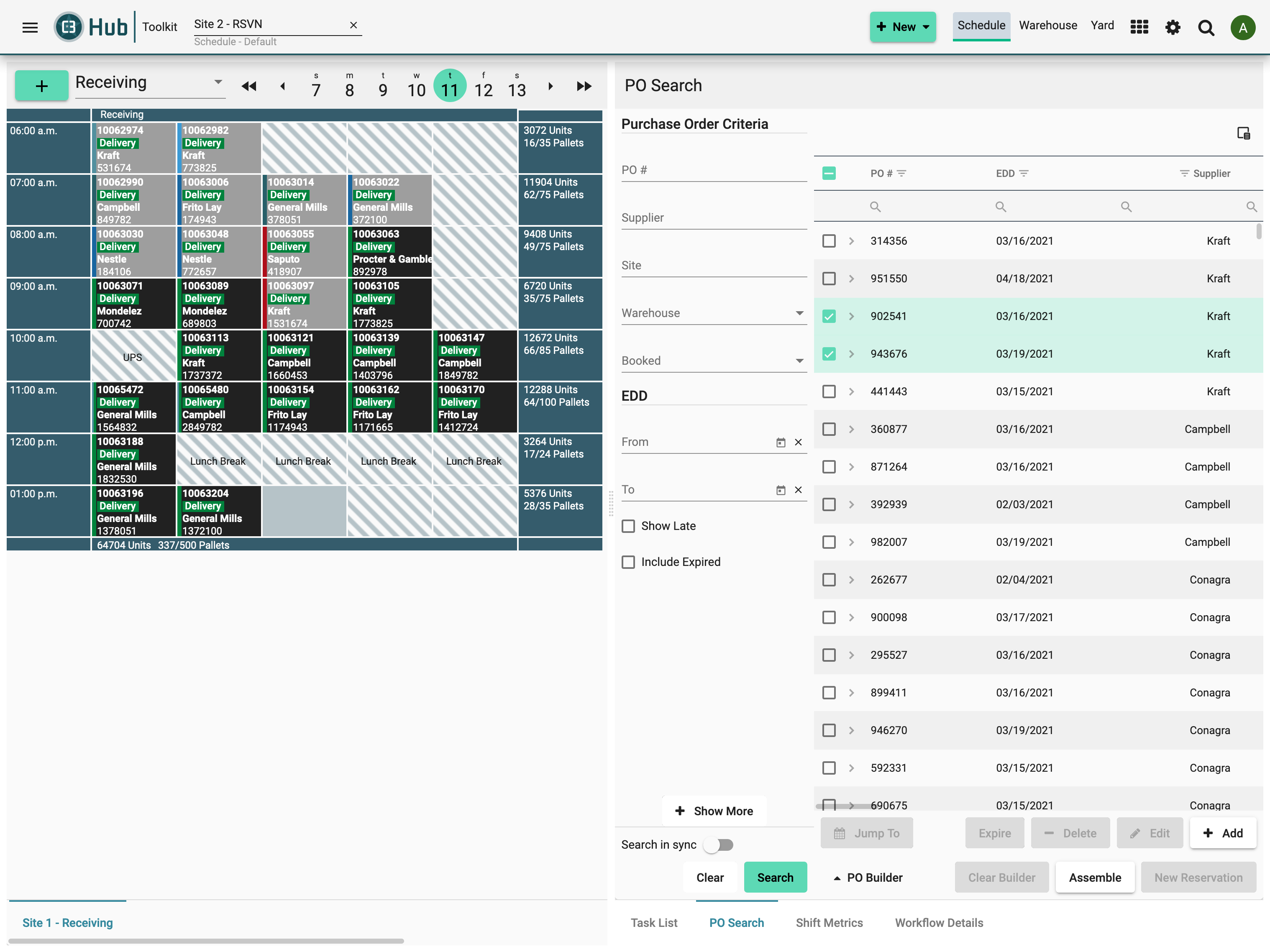Time Slot Management: The Key to Reducing Wait Times

Picture this: a Monday morning warehouse yard packed with people. Loading and unloading trucks lined up outside the facility. Drivers are getting impatient, even as warehouse teams scramble to keep dock schedules together.
The result? Delays, congestion, and the ripple effect of inefficiencies all along the supply chain. And as is inevitable, left with angry customers in the end.
This fractious environment is familiar to companies that experience time slot mismanagement in their warehouses. Today's warehouses are massive, with huge yards.
Trucks can arrive randomly without a defined system, creating a bottleneck, lost labor hours, mounting demurrage charges, and missed delivery deadlines. But it does not need to be like this.
A time slot management system can turn this shambles into a well-oiled operation like clockwork. The system allows warehouse teams to allocate specific delivery and pickup times for trucks to arrive and also inform them in case of any delay.
The result? Drivers know what to expect, fewer wait times for them, better coordination, and optimized warehouse operations.
But how does time slot management work, what business problems does it solve, and how can a successful system be implemented?
Let's discuss it in detail in this article.
What is Time Slot Management?
Time slot management controls time slots for delivery and pickups in a warehouse. By proactively managing the time slots of carriers and trucks, companies achieve smoother movements, reducing congestion and delays at warehouses. This enables simple scheduling with optimum dock utilization, easier yard management, and overall better warehouse management.
Think of it as a restaurant reservation system. If a popular restaurant doesn't take reservations, customers can walk in anytime, leading to long lines, extended waiting times, and unhappy customers. By booking tables ahead of time, restaurants keep a steady, manageable number of visitors.
Likewise, time slot management in supply chain strategies eliminates bottlenecks, reduces truck turnaround time, and simplifies loading & and unloading procedures.
But what happens when things don’t go as planned, like late carrier arrivals?
According to our survey, over 60% of companies re-schedule and notify stakeholders when a truck is running behind, while more than half create contingency plans or add buffer time to their schedules. Surprisingly, 37% still rely on manual adjustments, and over 12% admit they don’t have any formal strategy at all.
This tells us that many operations are still reactive when it comes to disruptions. Without a structured scheduling approach, delays can ripple through the entire supply chain.

Why Wait Times Matter
Let’s be clear! long wait times are more than just an inconvenience. They impact several key aspects of your operation:
-
Driver satisfaction: Extended delays mean lost hours, which affects morale and retention.
-
Carrier relationships: Repeated delays strain partnerships with logistics providers.
-
Labor costs: Inefficient scheduling can lead to overtime and idle dock workers.
-
Facility congestion: Too many trucks, not enough space—a logistical nightmare.
Unchecked wait times are more than just a nuisance, they’re a silent killer of efficiency. They impact your bottom line, your workforce, your relationships, and your reputation.
The good news? With Time Slot Management, you can take back control, reduce these bottlenecks, and keep your entire operation running like clockwork.
Benefits of Time Slot Management
Time Slot Management transforms your operation from being reactive to proactive. Instead of dealing with last-minute surprises and backlogs, it allows you to control your logistics schedule with precision. Below are the key benefits of implementing a time slot management system, and why it’s worth the investment.
Reduces Congestion and Idling
Unscheduled truck arrivals often lead to congestion at gates and docks, causing long lines and unnecessary engine idling. Time Slot Management allows for even distribution of trucks throughout the day, significantly reducing traffic build-up and overcrowded yards.
This not only improves flow and safety but also minimizes fuel waste and carbon emissions. For companies focused on sustainability, it’s a win-win: fewer delays and a smaller environmental footprint.
Improves Dock Efficiency
When you know who’s arriving and when, your warehouse team can prepare accordingly. Time Slot Management supports better labor allocation, faster staging, and shorter turnaround times.
With less scrambling and more planning, your docks become more productive. You can process more loads in less time using the same resources, leading to higher throughput and lower operational stress.
Boosts Carrier Experience
Carriers and drivers value predictability. Time Slot Management gives them the ability to plan their routes with confidence, knowing exactly when they’ll be received at your facility.
This reduces driver frustration, helps maintain their schedules, and makes your site more carrier-friendly. As a result, carriers are more likely to prioritize your facility, leading to stronger relationships and better service consistency.
Allows Data-Driven Planning
Every scheduled time slot generates data, data that can be analyzed to identify patterns and inefficiencies. With the right tools, you can track no-show rates, delayed arrivals, average dwell times, and peak usage windows.
These insights enable you to optimize operations: adjust staffing levels, prevent overloads, and improve carrier performance. Time Slot Management becomes not just a scheduling tool, but a source of strategic intelligence for continuous improvement.
Minimizes Detention Fees
When schedules run late, detention fees pile up, hurting both shippers and carriers. With Time Slot Management, you can dramatically reduce truck wait times and keep your operations flowing on time.
The result is lower detention costs, fewer billing disputes, and better compliance with service level agreements (SLAs). It's a direct way to improve profitability while strengthening carrier trust.
Enhances Stakeholder Collaboration
Time Slot Management creates a shared platform for communication between shippers, carriers, warehouse teams, and suppliers. Everyone works from a centralized schedule, reducing miscommunication and manual coordination efforts.
By bringing all stakeholders into one system, you create transparency, reduce unnecessary phone calls and emails, and ensure smoother logistics handoffs at every stage.From lower wait times and smoother operations to happier carriers and smarter decisions, the benefits ripple across your entire supply chain.
Challenges in Implementing Time Slot Management
The benefits are clear, but implementing a time slot management system has its own challenges. These are not significant challenges, but if ignored, they can derail implementation:
Opposition to Change: Employees and partners accustomed to traditional scheduling may resist switching to new systems because they may lose flexibility. Overcoming this resistance requires telling them about the long-term benefits through effective change management.
Technological Integration: Integrating a new time slot management system with existing technologies can be challenging. Compatibility and data integrations between systems are vital to successful implementation.
Data Accuracy: Time slot management is effective only when the data is accurate. Scheduling errors due to inaccurate or incomplete data can lead to adoption and trust issues, which are hard to overcome.
Scalability: As businesses grow in volume, scheduling becomes increasingly challenging. Hence, it is imperative to pick a time slot management system that is easily scalable to handle increasing volume and complexity.
Compliance and Standardization: Different regions or partners may have different compliance requirements and standards. Matching the time slot management system to meet all the compliances and ensuring standardization across all your locations becomes important.
The challenges can vary depending on the region, nature of the business, and more. For example, in cold chain logistics, fresh produce, or highly seasonal supply chains, the main challenge is minimizing waste. However, with the right partner, this becomes much easier to manage.
How to Integrate a Time Slot Management System
Choosing the right time slot management system for your business is a very critical step, as every business is unique. The implementation of a time slot management system involves a few steps:
Step 1: Assess your Needs
Start by gauging your needs from the system. Identify unique pain points, bottlenecks, and areas where time slot management can most benefit your company. Knowing these aspects provides the foundation for a successful implementation.
Step 2: Choose the Right System
Choose a time slot management system that meets all of your operational requirements, besides integrating with your existing systems. User-friendliness, scalability, and support are essential factors to consider when choosing a solution.
Step 3: Engage Stakeholders
Include suppliers, carriers, and internal teams from the planning stage and throughout the implementation journey. Their input and buy-in are critical to successful adoption and operation.
Step 4: Training
Ensure all users are trained on the new system. Proper training reduces resistance and errors, ensuring a smoother transition.
Step 5: Monitor and Adjust
After implementation, continuously monitor the system performance. After implementation, hypercare is the most critical phase in addressing teething issues. Get user feedback and adjust if necessary to correct problems or optimize for efficiency.
Improve Your Yard Efficiency With C3 Solutions
Poor inbound and outbound truck movements in the warehouse shouldn't hold the whole supply chain hostage. The right time slot management system will help you cut wait times, maximize resource utilization, and keep your operations running like clockwork.
At C3 Solutions, we focus on time slot management to optimize yard and dock operations. Our intelligent scheduling solutions eliminate bottlenecks, simplify appointment scheduling, and provide real-time visibility of truck arrivals and departures.
With C3’s intelligent time slot management system, you can:
✔ Reduce time spent scheduling by 50%
✔ Prevent overbooking of the dock
✔ Eliminate 90% of Calls and Emails
✔ Synchronize appointments with capacity
Connect with us today to see how C3 Solutions can help you manage your yard differently. Start your journey towards smoother, faster, and more effective logistics processes.




